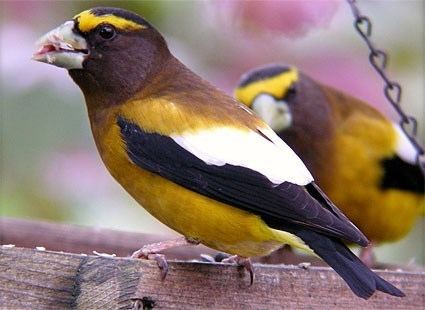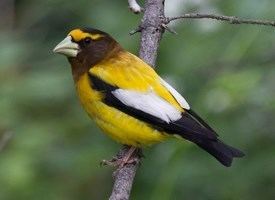Order Passeriformes Higher classification Coccothraustes | Phylum Chordata Family Fringillidae Genus Coccothraustes Rank Species | |
 | ||
Scientific name Coccothraustes vespertinus Similar Bird, Pine siskin, Finch, Purple finch, Pine grosbeak | ||
Evening grosbeak calls
The evening grosbeak (Coccothraustes vespertinus) is a passerine bird in the finch family Fringillidae found in North America.
Contents
Taxonomy

The International Ornithologists' Union and the Handbook of the Birds of the World place the evening grosbeak in the genus Hesperiphona. However, the species is named Coccothraustes vespertinus (in the same genus as the hooded grosbeak and the hawfinch) by the Clements Checklist and the American Ornithologists' Union.

The genus Hesperiphona was introduced by Charles Lucien Bonaparte in 1850. The name is from Ancient Greek hesperos, "evening", and phone "cry", and the specific vespertina is Latin for "evening".
Description

The evening grosbeak is similar in appearance to the Eurasian hawfinch, both being bulky, heavily built finches with large bills and short tails. The evening grosbeak ranges in length from 16 to 22 cm (6.3 to 8.7 in) and spans 30 to 36 cm (12 to 14 in) across the wings. In a large sampling of grosbeaks in Pennsylvania during winter, males weighed from 38.7 to 86.1 g (1.37 to 3.04 oz), with an average of 60 g (2.1 oz), while females weighed from 43.2 to 73.5 g (1.52 to 2.59 oz), with an average of 58.7 g (2.07 oz). Among standard measurements, the wing chord is 10.45 to 11.6 cm (4.11 to 4.57 in), the tail is 6 to 6.95 cm (2.36 to 2.74 in), the bill is 1.6 to 2 cm (0.63 to 0.79 in) and the tarsus is 1.95 to 2.2 cm (0.77 to 0.87 in). The adult has a short black tail, black wings and a large pale bill. The adult male has a bright yellow forehead and body; its head is brown and there is a large white patch in the wing. The adult female is mainly olive-brown, greyer on the underparts and with white patches in the wings.
Breeding and ecology
The breeding habitat is coniferous and mixed forest across Canada and the western mountainous areas of the United States and Mexico. It is an extremely rare vagrant to the British Isles, with just two records so far. The nest is built on a horizontal branch or in a fork of a tree.
The migration of this bird is variable; in some winters, it may wander as far south as the southern U.S.
These birds forage in trees and bushes, sometimes on the ground. They mainly eat seeds, berries, and insects. Outside of the nesting season they often feed in flocks. Sometimes, they will swallow fine gravel.
The range of this bird has expanded far to the east in historical times, possibly due to plantings of Manitoba maples and other maples and shrubs around farms and the availability of bird feeders in winter.
